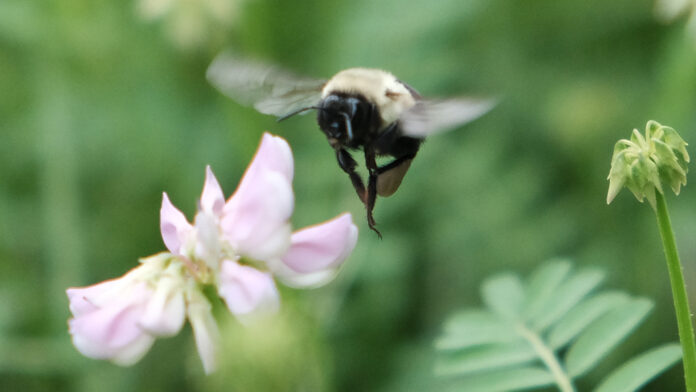Energy-saving method of flying allows bees to forage for food more efficiently
Bumblebees are the ultimate champions of carrying all their groceries home in a single trip. As UC Davis researchers discovered, bumblebees change their flight patterns to be efficient when carrying heavy loads of pollen and nectar.
Bumblebees exhibit a behavior called foraging as they travel from flower to flower finding food. Flowers provide all the food groups bees need: pollen and nectar. Pollen is high in protein and fat to help bee larvae grow in the hive, and nectar fuels adult bees as a source of sugar. Foraging is a necessary behavior for the survival of the hive, and bumblebees are surprisingly efficient at this task for their size.
“Bumblebees are like fuel tankers,” said Susie Gagliardi, a researcher in the Combes lab at UC Davis. “They carry much more than other insects, often because they’re bringing things back for the hive all the time. At the upper limit, they’re carrying about 80% of their own body weight. Flying with a full belly should be a huge cost for the bees.”
To measure how much energy each bee was using, researchers used tiny flight chambers made of modified snow globes. They pumped pure air without carbon dioxide into the chamber and encouraged the bee to fly for a few minutes with an overhead light simulating the sun. As bees burn energy while flying, they generate tiny amounts of carbon dioxide. The researchers used carbon dioxide measurements to determine how much energy each bee used when flying with light loads and heavy loads.
“If you imagine a person with this setup, they’d be running on a treadmill with a mask,” Gagliardi said. “You can’t put a mask on a bee, so we made an all-enveloping mask for them with the snowglobes.”
Researchers expected bees with heavy loads to burn significantly more energy than bees with light loads, but they found a surprising result: bees with the heaviest loads actually changed their flight pattern to fly more efficiently.
Bees carrying heavy loads burned more energy overall than bees with light loads, which was expected. But bees with heavier loads were actually more energy-efficient for the amount of weight they were carrying.
“Think about buying something at Costco,” explained Stacey Combes, an assistant professor of neurobiology, physiology and behavior. “It’s always going to be a little more expensive to buy that pack of 12 jars of spaghetti sauce, but per unit, it’s cheaper to buy in bulk. We’re finding something similar in bees. They are actually doing something to fly more efficiently when they’re carrying these heavy loads.”
This unexpected result raised more questions, including how bees could choose to fly in this new efficient method. Bee flight is typically measured using two factors: Frequency, which is how fast bees flap their wings, and stroke amplitude, which is how far their wings travel with each beat. Bumblebees deviated from the expected pattern and switched over to this “economy mode” to save energy when they carried the heaviest loads.
Understanding foraging behavior in bees is important to design beneficial habitats for them in agricultural areas. Bumblebees collect huge amounts of nectar and pollen for their hives and, in the process, they provide valuable pollination services to farmers.
“For example, [bumblebees] are one of the few wild bees capable of pollinating tomatoes,” wrote Jeremy Hemberger, a postdoctoral researcher in the department of entomology and nematology, via email. “Their ability to ‘buzz pollinate’ (vibrate at just the right frequency) is essential for releasing pollen from the anthers of the tomato flower.”
Many farmers rely on honey bees to pollinate crops — sometimes even transporting them cross-country for pollination season — but bumblebees provide equally important services. Crops, including squash, cranberries, blueberries and eggplants, are also buzz pollinated only by bumblebees.
Farmers can take advantage of bumblebee-provided pollination if they plant flower mixes in or around their fields. Providing this foraging source allows bumblebees to establish colonies nearby and bring back as much nectar to the hive as possible.
“Their services help to provide food for wild animals and humans — all free of charge,” Hemberger said. “While they’re not the only pollinating insect, they are among the most efficient for a number of economically important crops.”
Written by: Lauren Glevanik — science@theaggie.org




